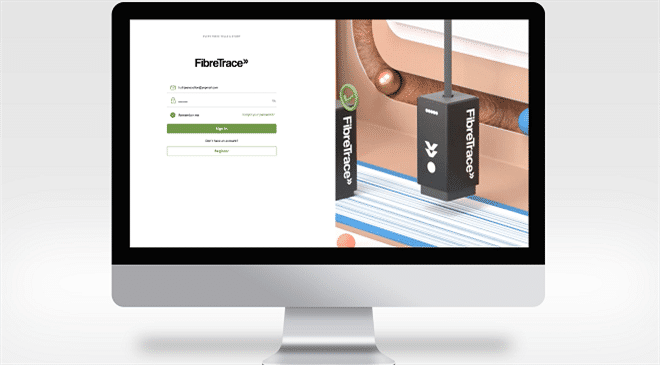Advanced Traceability Technology
Focused on fronting a new era of transparency, honesty and
accountability, FibreTrace’s mission is to ensure that every member of the
textile supply chain has the ability to take direct accountability to reduce
the environmental impact of the global industry. In doing so, the company aims
to ultimately provide the consumer the opportunity to choose a transparent and
sustainable supply chain to follow and purchase from. In a conversation with Fibre2Fashion,
CEO Shannon Mercer talks about transparency across the textile value
chain.
When and how did the idea for FibreTrace happen?
FibreTrace was founded in 2018 when we were connected with Paul Stenning, the founder behind our technology, to learn more about what traceability opportunities were available for the cotton industry. We built FibreTrace with a team of supply chain experts individually and through our own individual foresight after realising that even the most conscious suppliers were unable to guarantee complete custody of supply, and recognised an emerging conversation of transparency in the supply chain.
FibreTrace was created as a solution to enable 20/20 vision of a product from raw fibre to the finished garment and beyond into reuse and recycle and has been in a period of rapid growth since the technology was founded in 2018. We are grateful to the early adopters who have supported by way of contributing to ongoing research and development, piloting the technology, and providing their invaluable feedback. We appreciate the trust and future-focused vision of our early supporters who have carried us through countless milestones.
We are looking forward to the year ahead following the recent launch of FibreTrace MAPPED to the industry free of charge, and continue to pursue global supply chain traceability.
What is the kind of information that brands and consumers access by using FibreTrace?
Brands, manufacturers and raw fibre producers can tailor the information they receive, report, store and access on the FibreTrace platform to suit their needs. Information such as supplier name, location, and product are just the beginning – users can upload detailed product information, purchase orders, shipping documentation and certifications, all able to be centrally shared with supply chain partners globally.
Brands also have option to share this journey and supply chain information with the end consumer, using transparency as a tool to empower responsible consumption and facilitate consumer education.
Does the technology used withstand all kinds of textile processing?
The FibreTrace pigment is indestructible and will remain with the fibre for life. At such a minute ratio (0.01 per cent), the pigment is considered less than contamination by industry standards. Rigorous testing has ensured that FibreTrace pigment application can withstand the complete catalogue of textile processing with no effect on the quality or output of the yarn or fabric, or wearability of the garment.
Why is transparency important? Why are consumers and brands demanding it?
You can’t solve a problem you are not aware of. It is only with complete transparency, understanding the impact of raw fibre production on emissions, and ensuring that the claims made on environmental targets and individual products can be authenticated with tangible evidence that change for the better can take place.
Pressure has been building over many years from consumers, legislation and regulation, and internal factors for transparent supply chains as an essential strategy to improve the impact of the global textile industry environmentally and socially. With recognition of this, demand for traceability in the fashion industry is growing.
Social and human rights movements, combined with the implementation and changes of legislation around supply chain transparency, sustainability and accountability mean that organisations need to act and implement processes around traceability. Surprisingly, according to Avery Dennison’s December 2021 Digital Consumer Behaviour Report, fifty per cent of the world’s largest fashion brands continue to disclose little or no information about their supply chain and only twelve per cent of brands worldwide publish any insights into their raw material suppliers.
The shift in consumer consumption behaviours and growing demands for greater ethical and environmental responsibility has been a key driver for change and our hope with FibreTrace is to enable the industry to take a step forward towards a future that champions sustainable and ethical creation and consumption.
How does FibreTrace work? How do you ensure transparency across the supply chain?
FibreTrace gives textile brands and suppliers 20/20 vision of their supply chain at every step from raw fibre to store, providing brands and retailers with true custody of supply, the ability to quantify and audit fibre content, and access primary impact data for natural and man-made solutions.
At the core of the FibreTrace VERIFIED technology is a patented luminescent pigment that is embedded in raw fibres which is traced, verified and audited in real-time at each step of the global textile supply chain. This is achieved via a proprietary handheld FibreTrace Bluetooth scanner that identifies and quantifies pigments in fibre, yarn, fabric and finished goods that send encrypted data into secure blockchain software that was specifically engineered for the textile and apparel supply chain.
As an advanced traceability technology provider, FibreTrace can empower brands to accurately trace, validate, share, and promote their fibre choices. It is only through the power of this transparency that FibreTrace can assist the global fashion and textile industry in reducing its environmental impact.
In addition to our FibreTrace VERIFIED service, we have recently launched FibreTrace MAPPED, which is our new digital chain of custody tool which maps the global textile supply chain from fibre to retail, allowing brands, manufacturers and fibre producers to power transparency across all materials today.
Version one of FibreTrace MAPPED empowers users to visually map global supply chains, upload product information, purchase orders, shipping documentation and certifications – creating the chain of custody. Users can complete digital audits registered on the blockchain to effectively record the full production pathway. Brands utilising the tool have the option to share the supply chain details behind each product with the end consumer, empowering responsible purchase decisions.

What kinds of fibres and fabrics does the technology work on?
To date FibreTrace VERIFIED is successfully applied in market on cotton, recycled acrylic, recycled polyester, and responsible viscose. We have research and development pilots underway on wool, linen, hemp and leather. We look forward to releasing FibreTrace commercially on new fibre categories every year.
As a digital mapping tool, product traceability with FibreTrace MAPPED is limited only by the imagination. This is especially true as we look to future developments and expansions within our platform.
Can you tell us about some of your key partnerships and markets?
FibreTrace being a business intelligence and traceability tool, there is a lot of confidentiality around our partnerships, but we are excited that over 2023 and 2024 you will see more international brand houses celebrate the use of the technology on products and share supply chain insights with the consumer.
We first launched in November 2020 with Nobody Denim in Australia, then Reformation in March 2021, followed by Seven For All Mankind, Maggie Marilyn, Sir The Label, Cue Group and more. We have over 60 manufacturers on FibreTrace to date and this number is growing every month. Our key markets for adoption at fibre and manufacturing level have been Australia, Turkey, Vietnam, Portugal, Spain, Pakistan and India. Brands in Europe are predominately driving the adoption of traceability practices, and as of mid-2022 we saw the increase on prioritisation of traceability from US brand houses.
FibreTrace supports fashion manufacturers, from spinners to garment makers, to trace their products and showcase integrity through verification, elevating the role of the responsible farmer or raw fibre producer, by tracing and protecting fibre integrity as it moves throughout the global supply chain.
We also celebrate formal collaborations with The Higg Co (part of the Sustainable Apparel Coalition) and SGS (global leading auditor), which foster robust sharing of environmental data and audited data pathways as we transition more brands to traceable practice.
How long can the fibres marked with FibreTrace be traced?
The patented FibreTrace VERIFIED pigment stays within the garment for life. Fibres are marked with FibreTrace in early-stage processing, which enables tracing throughout the supply chain from source to store, and beyond – through upcycling, recycling and even incineration.
What new innovations are you working towards? What new applications do you foresee?
Last month, January 2023, we were pleased to release FibreTrace MAPPED to the industry free of charge, with the intention of supporting the industry by eliminating the financial barrier that often stands in the way of industry players being unable to map their global supply chain. We look forward to developing this technology and expanding its capabilities as we learn about how the market choses to make the most of the traceability tool. We are excited to bring this solution to the industry and encourage brands and manufacturers to trace their supply chain at no cost. As for FibreTrace VERIFIED, we look forward to commercialising application to linen and wool in 2023, and hopefully seeing successful R&D completion on leather and other fibre categories.
What future do you foresee for your technology?
We’re hopeful for a future where all brands can take full ownership of their supply chain, and the full impact on their individual goods. We see our technology playing a part in this movement. As traceability becomes intertwined with the global legislature, this utopia seems entirely likely. As global benchmarks for corporate accountability and disclosure of fibre provenance, supply chain management and supply chain traceability are not far off.
We hope to see both our technologies—FibreTrace MAPPED and FibreTrace VERIFIED—empower brands and manufacturers to accept accountability for their supply chain choices, and the impact their decisions have on the environment and community globally.


